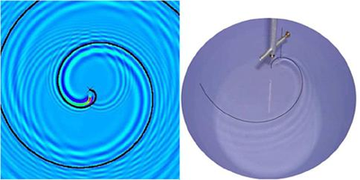March 4, 2008 feature
Weird wave behavior may explain why the whirligig walks in circles

The whirligig beetle is named for its trademark of walking in circles on the surface of water. Upon investigating a new phenomenon of water wave generation, scientists might now understand why.
Researchers from France have found that objects moving in circles on the surface of water exhibit a striking difference from objects moving in straight lines. Straight-moving objects require a minimum velocity to generate even tiny ripples in the water. But when moving in a circular trajectory, objects moving at much lower velocities can still create waves. In fact, the scientists demonstrate that no velocity threshold exists for objects moving in circles to generate waves.
Alexei Chepelianskii and Elie Raphaël of the City of Paris Industrial Physics and Chemistry Higher Educational Institution (ESPCI), and Frédéric Chevy of the University of Paris have published the results of their study in a recent issue of Physical Review Letters.
Waves generated by boats, insects, and other objects moving at the water-air interface are called capillary-gravity waves. They are caused by a balance between the liquid’s tendency to stay flat due to gravity and surface tension, and the outside force of the object that disturbs the liquid’s equilibrium. The waves often occur in the form of ripples behind boats (and, as the cause of drag, are preferably kept to a minimum for boating).
Capillary-gravity waves move across the water at a minimum velocity of 23 cm/s, below which point they just can’t overcome the gravity and surface tension of the liquid. So it was generally thought that all objects must move at this minimum velocity or greater in order to create the waves. However, the recent study shows that small objects moving below 23 cm/s can still generate waves, as long as the objects are moving in circles.
“The speed of the waves generated by the rotating object or animal is, as always, larger than 23 cm/s,” Raphaël explained to PhysOrg.com. “This does not violate any law of physics. For instance, when one drops a stone in water, the impact generates circular waves, while the velocity of the stone parallel to the surface is strictly zero.”
The researchers demonstrated this behavior both theoretically and experimentally. By moving a needle in circles in a bucket of water and using a laser to measure the waves, the researchers detected waves when the needle’s velocity was around 14 cm/s – just 0.6 times the minimum wave velocity. Below this velocity, the signal-to-noise ratio was too small to observe the laser deflection.
The researchers explain that the cause of this special case is directly related to the accelerated nature of the circular motion. They compare the behavior to that of Cherenkov radiation, which is electromagnetic radiation (which travels at the speed of light) emitted by a charged particle traveling at greater than the speed of light in a certain medium (but slower than the speed of light in air).
As the researchers explain, “just like accelerated charged particles radiate electromagnetic waves even while moving slower than the speed of light, an accelerated disturbance experiences a nonzero wave resistance Rw even when propagating below cmin [the minimum wave velocity].”
The group explains that the findings do not contradict the minimum velocity threshold, which is only valid for rectilinear uniform motion – an assumption that is, however, often overlooked in the literature.
Discover the latest in science, tech, and space with over 100,000 subscribers who rely on Phys.org for daily insights. Sign up for our free newsletter and get updates on breakthroughs, innovations, and research that matter—daily or weekly.
“This is a very general phenomenon in physics: waves of any sort can be generated by accelerated objects,” Raphaël said. “Let's consider, for instance, the case of sound waves: you can emit sounds by moving periodically the membrane of a loudspeaker or the vocal cords – since the motion is periodic, the velocity is necessarily non-constant in time.”
As for the whirligig, it may use this wave behavior to its advantage. The researchers predict that the circular walking beetles might generate surface waves for echolocation, enabling them to navigate at low velocities. The team hopes that the new findings will also lead to insights into how small animals travel efficiently on the surface of water.
“Several insect species are thought to use waves at the surface of water as an analogue of SONAR, where ultrasound waves would be replaced by capillary-gravity waves,” Raphaël said. “We think that this property of circular motion can facilitate echolocation in two ways. For one, it makes the emission of waves easier since the insect can move slower than 23 cm/s. Also, the waves that are emitted are isotropic: there is no ‘blind spot,’ and the insect can therefore perceive in any direction an object (obstacle, prey, predator or fellow whirligig) at the surface of water.”
More information: Chepelianskii, A. D., Chevy, F., and Raphaël, E. “Capillary-Gravity Waves Generated by a Slow Moving Object.” Physical Review Letters 100, 074504 (2008).
Copyright 2008 PhysOrg.com.
All rights reserved. This material may not be published, broadcast, rewritten or redistributed in whole or part without the express written permission of PhysOrg.com.





















